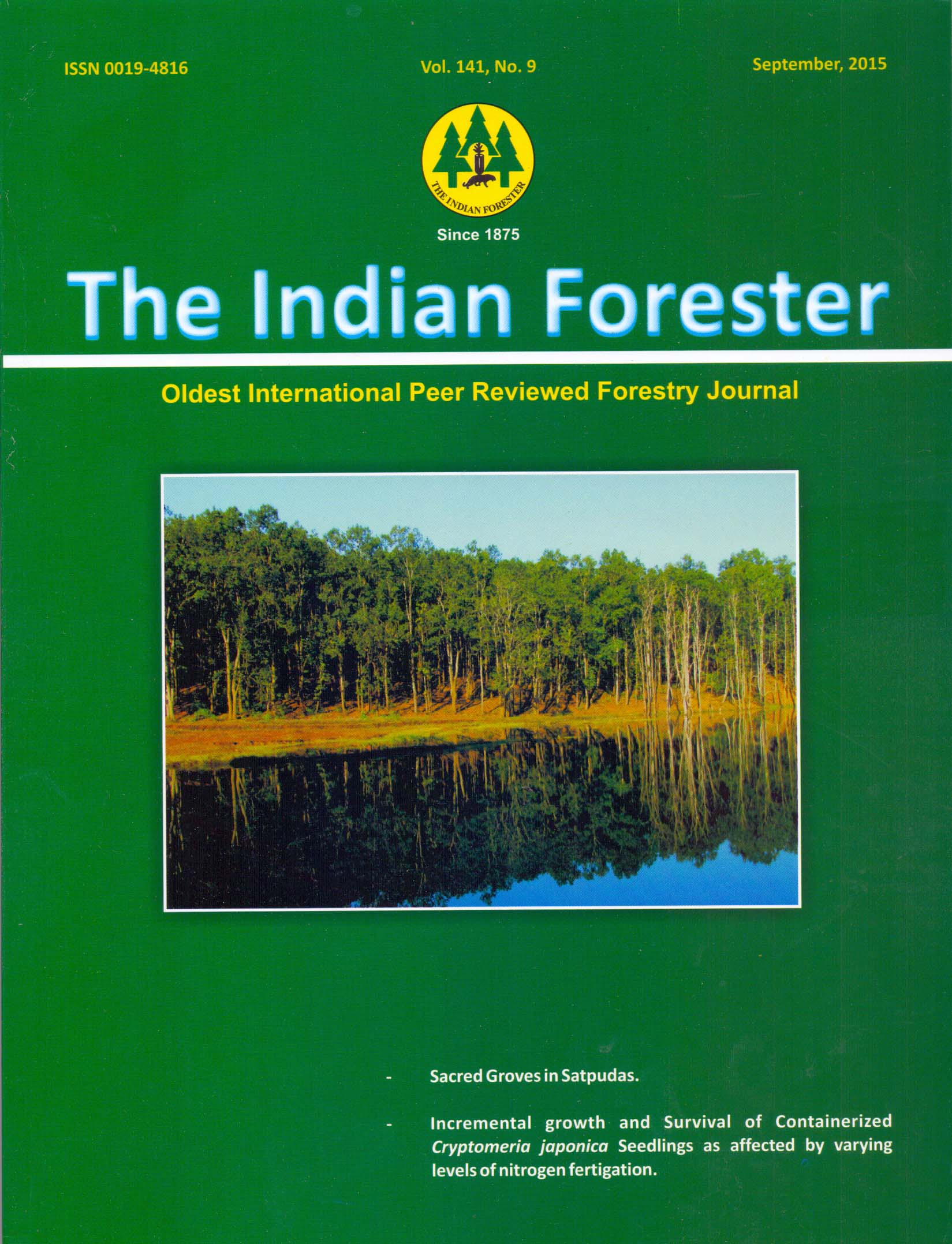Species-Area Relationships in the Tropical Deciduous Forests of Jharia Coalfield, India
DOI:
https://doi.org/10.36808/if/2015/v141i9/79862Keywords:
Coal Mine, Quadrat, Sar, Species Richness, Tropical Deciduous Forests.Abstract
Species-area relationships (SARs) were characterized the spatial distributions of legumes and nonlegumes in three sites of the tropical deciduous forests around Jharia Coalfield (JCF) in the eastern part of India. Three 1 ha plots were established one in each site, located 6 to 20 km apart. Each plot was divided into 100 quadrats each of 10 m × 10 m in size. The observed species-area curves were initially steep followed by gradual species accumulation, but none of the sites did the curve reach an asymptote. These curves were best fitted by the power model due to low P value 2 (probability under the null hypothesis), high F ratio (regression mean square over the error mean square) and high Ra (adjusted coefficient of determination) indicating 1 ha sampling plots were intermediate in size in three sites. In this study, the Z-value decreased with increase in C-value indicating both were simply fitted constant and independent of biotic and abiotic characteristics of the sampling sites. The species-area relationships showed distinct habitat heterogeneity and dispersal limitation for "all species, legumes and nonlegumes" in the tropical deciduous forests.References
Archibald E.E.A. (1949). The specific character of plant communities. II. A quantitative approach, J. Ecol., 37: 260-274.
Arrhenius O. (1923). Statistical investigation in the constitution of plant associations, Ecology, 4: 68-73.
Boecklen W.J. and Gotelli N.J. (1984). Island biogeographic theory and conservation practice: species-area or specious-area relationships, Biol. Conserv., 29: 63-80.
Champion H.G. and Seth S.K. (1968). A Revised Survey of Forest Types of India. Manager of Publications, Government of India, Delhi, India.
Coleman B.D., Mares M.A., Willig M.R. and Hsieh Y.H. (1982). Randomness, area, and species richness, Ecology, 63: 1121-1133.
Condit R., Hubbell S.P., Lafrankie J.V., Sukumar R., Manokaran N., Foster R.B. and Ashton P.S. (1996). Species-area and species-individual relationships for tropical trees: A comparison of three 50-ha plots, J. Ecol., 84: 549–562.
Connor E.F. and McCoy E.D. (1979). The statistics and biology of the species-area relationship, Am. Nat., 113: 791-833.
Crawley M.J. and Harral J.E. (2001). Scale dependence in plant biodiversity, Science, 291: 864-868.
de Candolle A. (1855). Geographie botanique raisonnee: ou l'exposition des faits principaux et des lois concernant la distribution geographique des plates de l'epoque actuelle. Maisson, Paris.
Gleason H.A. (1922). On the relation between species and area, Ecology, 3: 158-162.
Goodall D.W. (1952). Quantitative aspects of plant distribution, Biol. Rev., 27: 194-245.
Haines H.H. (1921-25). The Botany of Bihar and Odisha, 6 parts, Adlard & Sons, London.
Harte J., Kinzig A. and Green J. (1999). Self-similarity in the distribution and abundance of species. Science, 284: 334–336.
He F. and Legendre P. (1996). On Species-Area Relations, The Am. Nat., 148(4): 719-737.
Hubbell S.P. (2001). A Unified Neutral Theory of Biodiversity and Biogeography. Princeton, NJ: Princeton University Press.
Hubbell S.P. and Foster R.B. (1983). Diversity of canopy trees in a Neotropical forest and implica- tions to conservation. In S.L. Sutton, T.C.
Whitmore, and A.C. Chadwick, eds. Tropical rain forest: ecology and management. Blackwell Scientific, Oxford. pp 25-41.
Jaccard P. (1902). Lois de distribution florale dans la zone alpine, Bulletin de la Societe Vaudoise des Sciences Naturelles, 38: 69-130.
Kadavul K. and Parthasarathy N. (1999). Plant diversity and conservation of tropical semi-evergreen forest in the Shervarayan hills of Eastern Ghats, India, Biodivers. Conserv., 8: 421-439.
Laurance W.F. (1999). Reactions on the tropical deforestation crisis, Biol. Conserv., 91: 109-117.
Lawrey J.D. (1991). The species-area curve as an index of disturbance in saxicolous lichen communi- ties, Bryologist, 94: 377-382.
May R.M. (1975). Patterns of species abundance and diversity. In: Ecology and evolution of communities (M.L. Cody and J.M. Diamond, eds.). Belknap, Cambridge, Mass. pp 81-120.
May R.M. and Stumpf M.P.H. (2000). Species-area relations in tropical forests, Science, 290: 2084-2088.
Mooney H.F. (1950). Supplement to the Botany of Bihar and Odisha, Catholic Press, Ranchi.
Palmer M.W. and White P.S. (1994). Scale dependence and the species-area relationship, Am. Nat., 144:717-740.
Pimm S.L. (1998). Biodiversity as everything, Quarterly Review of Biology, 75: 51–54.
Rasingam L. and Parathasarathy N. (2009). Tree species diversity and population structure across major forest formations and disturbance categories in Little Andaman, India, Trop. Ecol., 50(1): 89-102.
Rosenzweig M.L. (1995). Species Diversity in Space and Time. Cambridge: Cambridge University Press.
Sagar R., Raghubanshi A.S. and Singh J.S. (2003). Tree species composition, dispersion and diversity along a disturbance gradient in a dry tropical forest region of India, For. Ecol. Manage, 186: 61–71.
Sagar R. and Singh J.S. (2005). Structure, diversity, and regeneration of tropical dry deciduous forest of northern India, Biodivers. Conserv., 14: 935–959.
Triantis K.A., Guilhaumon F. and Whittaker R.J. (2012). The island species-area relationship: biology and statistics, J. Biogeogr., 39: 215-231.
Tripathi O.P., Upadhaya K., Tripathi R.S. and Pandey H.N. (2010). Diversity, Dominance and Population Structure of Tree Species along Fragment-Size Gradient of a Subtropical Humid Forest of Northeast India, Res. J. Environ. Earth Sci., 2(2), 97-105.
Weiher E. 1999. The combined effect of scale and productivity on species richness, J. Ecol., 87: 1005-1011.
Williamson M. (1981). Island populations. Oxford University Press, Oxford.
Wilson E.O. (1988). Biodiversity. Washington: National Academy Press.
Downloads
Downloads
Published
How to Cite
Issue
Section
License
Unless otherwise stated, copyright or similar rights in all materials presented on the site, including graphical images, are owned by Indian Forester.





